Learn Android app development in easy steps
Download as PPTX, PDF6 likes2,785 views
Mobile Pundits is a leading provider of Outsource Mobile Development & Mobile Testing services. If you are looking for to develop any android application to grow your business fast, kindly visit our official website wwwdotmobilepunditsdotcom
1 of 34
Downloaded 66 times
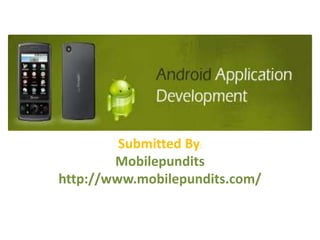
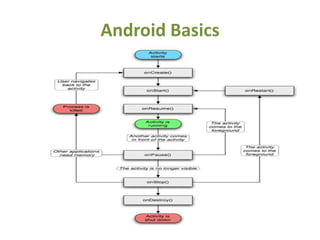
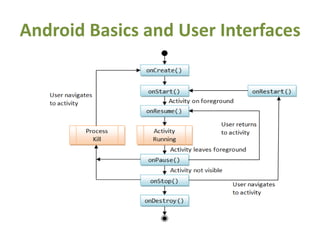
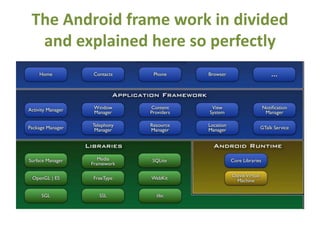
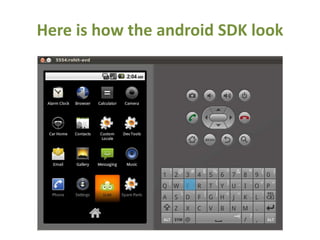
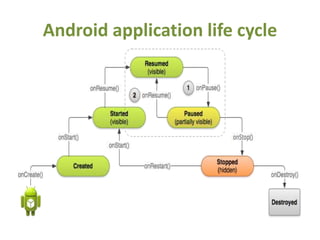
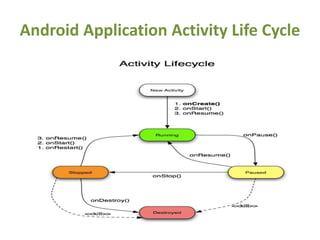
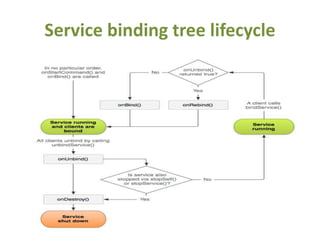
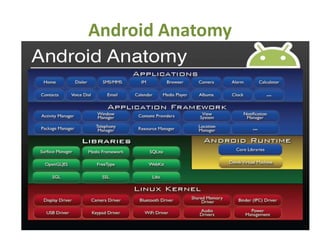
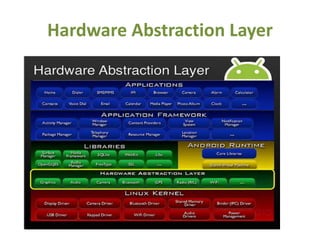
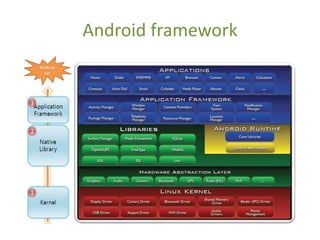
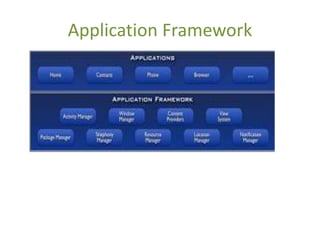
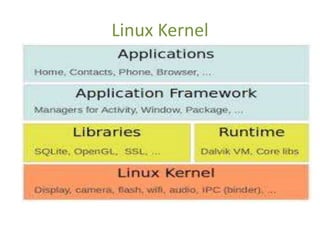
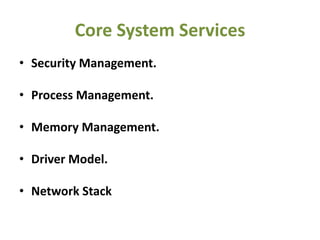
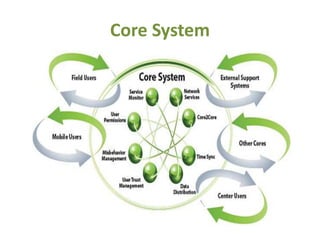
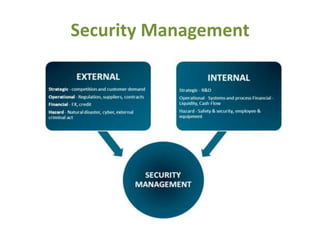
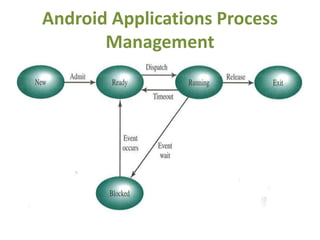
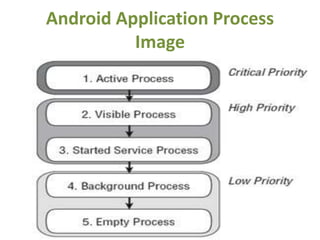

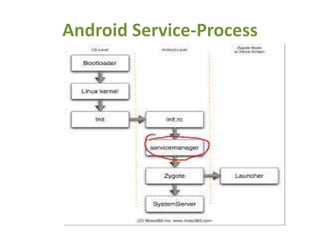
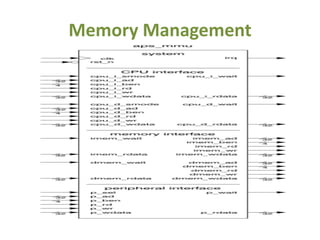
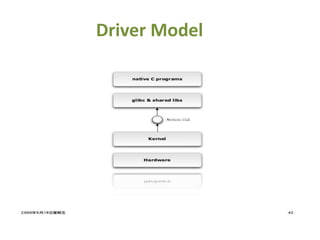
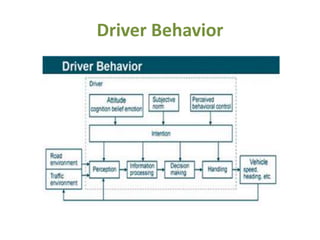
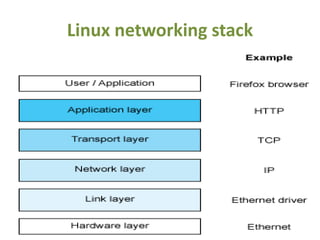
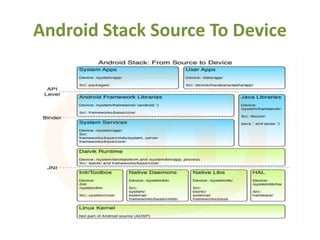
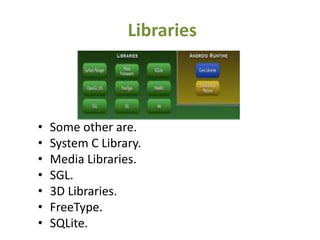



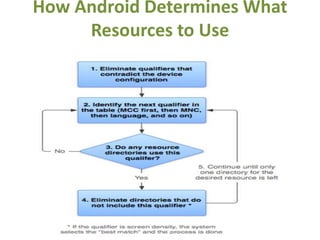
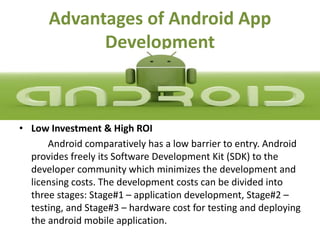
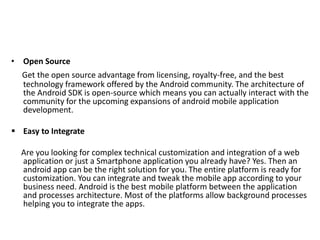
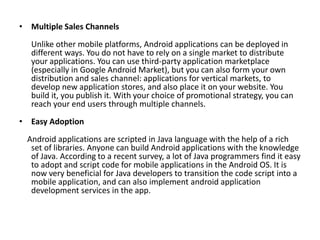

Recommended
Android Apps Development Basic



Android Apps Development BasicMonir Zzaman
Ěý
This Presentation slide include all the basic things that need to know a beginner to start his/her android career. Even though this slide presentation for beginner but mid level developer also could be benefited.Android ppt



Android pptVENGADESH P
Ěý
Android is an open-source, Linux-based operating system primarily used on touchscreen mobile devices. It was developed by Android Inc., which was acquired by Google in 2005. The document discusses Android's history and architecture, security features, advantages over other operating systems, supported hardware and software, hidden features, and interesting Android apps. It concludes that Android is a diverse and widely used mobile operating system that can be easily used by people of all education levels.Android ppt



Android pptGovind Raj
Ěý
This document provides an overview of the Android operating system. It discusses that Android is an open-source, Linux-based software stack for mobile devices. The document outlines Android's architecture which includes the Linux kernel, libraries, Android runtime and application framework. It also describes how to develop Android applications using building blocks like activities, intents and services. The document notes both advantages of Android like its open nature and portability, as well as disadvantages regarding security and open-source issues.Android Programming



Android ProgrammingPasi Manninen
Ěý
This document provides an overview of Android programming. It defines Android as an open-source operating system and development platform for mobile devices. Key points covered include Android's version history, core features and capabilities, the software stack and development framework, important terminology, and application fundamentals. Native Android applications like email, SMS, and maps are also briefly mentioned.Introduction to Android 



Introduction to Android Ranjith Kumar
Ěý
Android is an open-source operating system based on the Linux kernel. It was developed by the Open Handset Alliance, a consortium of technology companies including Google. Some key features of Android include an application framework for building reusable apps, the Dalvik virtual machine for running apps, and integrated core apps like a browser and SQLite for data storage. Future possibilities for Android include overtaking iPhone sales by 2012 and expanding beyond mobile devices to products like GPS units and set-top boxes.Android Programming Seminar



Android Programming SeminarNhat Nguyen
Ěý
This slide from Android Application Programming Seminar at a Technical University of Vietnam.
Throughout the slide, audience will have the general knowledge about Android OS, Architecture. The slide also provide the Android Application structure, the choices of framework or language to develop an Android application.
Real Time Audio is an application is written for this seminar.
Everyone can download from Google Play:
https://play.google.com/store/apps/details?id=junoteam.com.realtimerecording
What's new in Android Pie



What's new in Android PieHassan Abid
Ěý
Android Pie, the latest release of Android, is officially available to World. In this talk, I will summarize new features and behaviour changes. This session will be useful for developers as well product managers who are getting their apps ready for Android 9.PPT on Android



PPT on AndroidSubhadip Chakraborty
Ěý
Android was founded in 2003 and was later acquired by Google in 2005. It was developed as an open source platform to lower the cost of developing mobile devices and services. The Android operating system is based on a Linux kernel and has gone through many versions named after desserts or sweets, starting with Cupcake in 2009 to the current KitKat version. It provides an open development platform and uses Linux for core functions like memory management and device drivers.Android history,features,applications,hardware development and versions



Android history,features,applications,hardware development and versionsItsJames00
Ěý
Android is a mobile operating system developed by Google, based on the Linux kernel and designed primarily for touchscreen mobile devices such as smartphones and tablets.Android Development: The Basics



Android Development: The BasicsMike Desjardins
Ěý
Overview of the basics of Android software development. Presented to TechMaine's MaineJUG on June 21, 2011. Android workShop



Android workShopSrinivas Devarapalli
Ěý
The document provides an overview of Android including its evolution, versions, architecture and requirements. Some key points:
- Android was developed by Android Inc. which was acquired by Google in 2005. It is an open source operating system based on Linux.
- The Open Handset Alliance was formed in 2007 with Google and 84 companies to develop open standards for mobile devices.
- The first Android device was the HTC Dream released in 2008 running Android 1.0. There have been many versions since, up to the current 4.2.
- Android is a multi-user operating system that uses Linux kernel, native libraries and Java applications. It supports low-cost customization.
- By 2010 Android overtook SymbPresentation on Android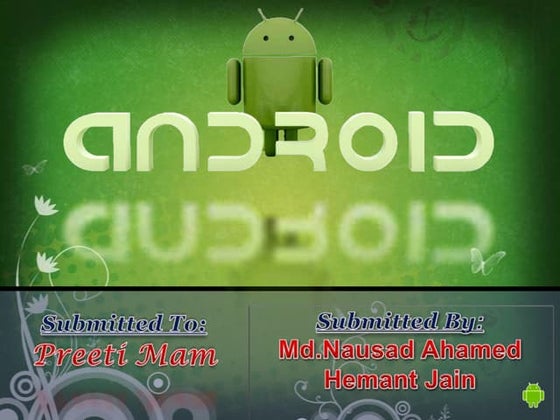



Presentation on AndroidNausad Ahamed
Ěý
For Better effect and transition run this ppt file to PowerPoint 2010.. :)
please Don't Forget to rate and Leave feedback...
Thanks :)Android Seminar || history || versions||application developement 



Android Seminar || history || versions||application developement Shubham Pahune
Ěý
Android is an open source software platform and operating system for mobile devices. It is based on the Linux kernel and allows developers to write managed code using Java. Google developed Android originally and later formed the Open Handset Alliance. Key aspects include its use of Java, Dalvik virtual machine, app marketplace, and open source nature. It has gone through several versions labeled after dessert names. Development tools include Android Studio, the official IDE, and requires installing the Java Development Kit and Android SDK.Android ppt



Android pptIndumathy Mayuranathan
Ěý
This document provides an overview of the Android operating system, including its history, architecture, versions, features, advantages, and disadvantages. Android was founded in 2003 and was later acquired by Google in 2005. It uses an open source Linux kernel and is developed by the Open Handset Alliance. The architecture consists of four layers - the Linux kernel, native libraries, the Android runtime (Dalvik virtual machine), and applications. Key features include multi-tasking, a rich application ecosystem, and integration with Google services. Advantages are customization and openness, while disadvantages include inconsistent designs between apps and battery drain issues on some devices.Android Applications



Android ApplicationsNazeer Hussain University
Ěý
This document provides an overview of Android, including its history, versions, architecture, security features, advantages, and disadvantages. Android was founded in 2003 and is an open-source operating system based on the Linux kernel. It uses Java for application development and includes features like multi-touch interaction, accelerometers, and GPS. The Android architecture consists of applications, an application framework, native libraries and the Linux kernel. Security is enforced through process isolation and permissions. While Android provides customization, app availability and integration with Google services, disadvantages include inconsistent designs between apps, battery drain, and lack of control over third-party apps in the Android Market.Android tutorial points



Android tutorial pointsbsb_2209
Ěý
This document provides an overview and tutorial on Android application development. It discusses what Android is, its features, and how to set up the development environment, including installing Java, the Android SDK, Eclipse IDE, and configuring an Android virtual device. It also covers Android architecture, application components, and provides a basic "Hello World" example app. The document is intended for beginners to help them understand Android programming.Android technology prepared by Hritika Raj (Shivalik college of engg.)



Android technology prepared by Hritika Raj (Shivalik college of engg.)Hritika Raj
Ěý
Leading technology of this era developed by the Andy Rubin, Rich Miner, Nick Sears and Chris White and it was was purchased by the GOOGLE in AUGUST,2005 for 50 million $.
Android overview



Android overviewAhmed M. Abed
Ěý
Android is an open source operating system designed primarily for touchscreen mobile devices. It uses Linux for core functions like memory and process management and includes features like an open application marketplace (Google Play), built-in security protections, and regular updates to newer platform versions codenamed after desserts. Android's flexibility allows it to run on a variety of hardware, expand its functionality through customization, and offer developers an easy environment to create applications for a wide user base.Android ppt



Android pptPooja Garg
Ěý
This document discusses Android, an open source software stack for mobile devices. It is a complete system comprising an operating system, middleware, and key applications. Android is developed as part of the Open Handset Alliance and is powered by the Linux kernel. It uses Java for application development and includes APIs for graphics, data storage, media, Bluetooth, WiFi and more. Developers write Android apps in Java, which are then compiled to Dalvik bytecode and run on Android devices.Android report.



Android report.Shivananda Rai
Ěý
Android is an open source operating system developed by Google and the Open Handset Alliance. It uses a Linux kernel with Java applications running in a Dalvik virtual machine. The Android architecture includes libraries and APIs for application developers as well as core applications. Developers can create Android apps using Java in the Eclipse IDE along with the Android SDK. While Android offers an open development platform, security and lack of control by Google are potential disadvantages.Android - A brief introduction



Android - A brief introductionRoshan Gautam
Ěý
Android is an open-source operating system developed by Google and the Open Handset Alliance. It allows developers to write managed code in Java and includes features like widgets, Bluetooth, WiFi support, and a wide range of media formats. While being open-source offers customization and cheap development, it also means the platform is more vulnerable to exploits and malware compared to closed systems.Evolution of android operating system



Evolution of android operating systemMd. Abdullah Al Maruf
Ěý
Android is an open source, Linux-based operating system originally developed by Android Inc. which was later acquired by Google. It is designed primarily for touchscreen mobile devices like smartphones and tablets. Some key points about Android include:
- It is currently the most widely used mobile OS in the world.
- New versions are named after desserts or sweets in alphabetical order and add new features and improvements.
- It is developed as open source software but devices ship with proprietary software and apps from manufacturers.
- Google has played a key role in its development and promotion through acquisition of Android Inc. and release of Nexus devices.Android ppt 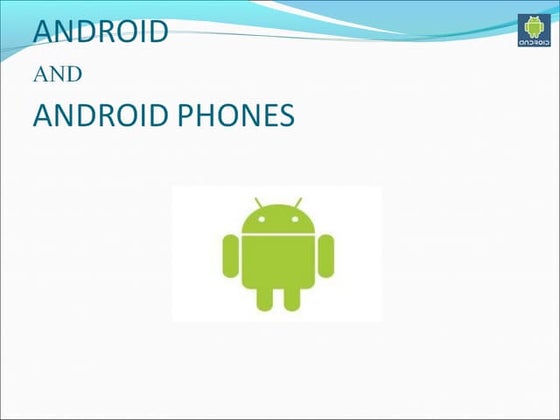



Android ppt blogger at indiandswad
Ěý
This document provides an overview of the Android operating system, including its history, architecture, versions, features, advantages, and disadvantages. Android was founded in 2003 and was later acquired by Google in 2005. It uses an open source Linux kernel and is developed by the Open Handset Alliance. The architecture consists of four layers - the Linux kernel, native libraries, the Android runtime (Dalvik virtual machine), and applications. Key features include multi-tasking, a rich application ecosystem, and integration with Google services. Advantages are customization and openness, while disadvantages include inconsistent designs between apps and battery drain issues on some devices.PPT Companion to Android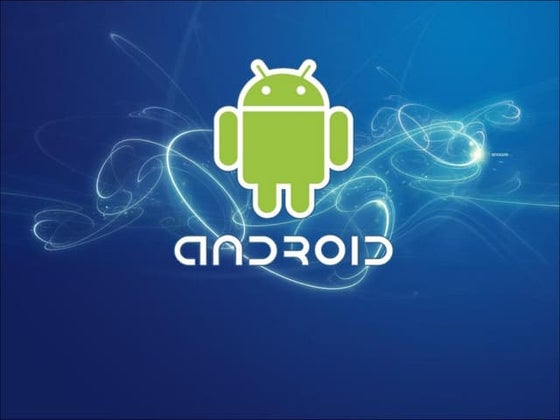



PPT Companion to AndroidDharani Kumar Madduri
Ěý
- Android is an open source software platform for mobile devices based on the Linux kernel and managed by the Open Handset Alliance. It allows developers to write managed code in Java for the applications layer.
- The Android software stack includes the Linux kernel, native libraries, the Android runtime (which includes a Java virtual machine called Dalvik), and the Application Framework layer where Android applications run.
- Android applications are built using the Android SDK and its tools which allow compilation of Java code into an executable .apk file that can be installed and run on Android devices.Android ppt



Android pptAnsh Singh
Ěý
This document provides an overview of Android mobile application development including:
- Android is an open source software stack for mobile devices including an operating system, middleware, and key applications.
- The Android software architecture includes components like the Linux kernel, libraries, Android runtime, application framework, and applications.
- Key building blocks for Android applications include activities, intents/intent receivers, services, and content providers.
- The Android SDK and Eclipse IDE can be used for application development along with emulators and real devices.Introduction to Android - Seminar



Introduction to Android - SeminarAkshay Sharma
Ěý
This document provides information about an upcoming free online seminar on Android development on February 19, 2017. It discusses what Android is, the Android platform including hardware, operating system, network connectivity and security. It also outlines the software development process for Android including requirements, IDEs and tools, programming languages and provides an overall evaluation of Android along with benefits of learning Android development. Contact information is provided at the end for anyone interested in registering for the seminar.Android PPT



Android PPTVivek Gautam
Ěý
This presentation provides an overview of the Android operating system. It discusses that Android is an open-source, Linux-based operating system developed by Google and the Open Handset Alliance for use in mobile devices. Key points covered include Android's open-source nature, features, supported devices, history and versions. The presentation also compares Android to the iPhone and outlines Android's development environment and widespread use in over 190 countries.Introduction to android basics



Introduction to android basicsHasam Panezai
Ěý
Android is an open source software platform that includes an operating system, middleware and key applications. It is based on Linux and developed by Google. Developers write managed code using Java-like language and Google libraries. The architecture includes application, framework, and Android runtime layers. Key framework components include activity manager, resource manager and location manager. Developing Android apps requires knowledge of Java, XML, Android SDK and Eclipse IDE. Important tools include aapt, adb and dx. Application fundamentals include activities, services, broadcast receivers, content providers and intents. Activities present a visual UI, services run in the background, and broadcast receivers receive system broadcasts. The activity lifecycle includes active, paused and stopped states.Android Apps for Absolute Beginners



Android Apps for Absolute BeginnersVaclav Hnizda
Ěý
The document introduces Vaclav Hnizda and provides an overview of Android apps for beginners. It discusses Android's history and architecture, the application lifecycle, options for storage, media, and screens. It also covers considerations for stand-alone apps, network connections, and deciding between HTML5 or native apps. The document aims to help beginners understand key concepts to get started building their first Android app.More Related Content
What's hot (20)
Android history,features,applications,hardware development and versions



Android history,features,applications,hardware development and versionsItsJames00
Ěý
Android is a mobile operating system developed by Google, based on the Linux kernel and designed primarily for touchscreen mobile devices such as smartphones and tablets.Android Development: The Basics



Android Development: The BasicsMike Desjardins
Ěý
Overview of the basics of Android software development. Presented to TechMaine's MaineJUG on June 21, 2011. Android workShop



Android workShopSrinivas Devarapalli
Ěý
The document provides an overview of Android including its evolution, versions, architecture and requirements. Some key points:
- Android was developed by Android Inc. which was acquired by Google in 2005. It is an open source operating system based on Linux.
- The Open Handset Alliance was formed in 2007 with Google and 84 companies to develop open standards for mobile devices.
- The first Android device was the HTC Dream released in 2008 running Android 1.0. There have been many versions since, up to the current 4.2.
- Android is a multi-user operating system that uses Linux kernel, native libraries and Java applications. It supports low-cost customization.
- By 2010 Android overtook SymbPresentation on Android



Presentation on AndroidNausad Ahamed
Ěý
For Better effect and transition run this ppt file to PowerPoint 2010.. :)
please Don't Forget to rate and Leave feedback...
Thanks :)Android Seminar || history || versions||application developement 



Android Seminar || history || versions||application developement Shubham Pahune
Ěý
Android is an open source software platform and operating system for mobile devices. It is based on the Linux kernel and allows developers to write managed code using Java. Google developed Android originally and later formed the Open Handset Alliance. Key aspects include its use of Java, Dalvik virtual machine, app marketplace, and open source nature. It has gone through several versions labeled after dessert names. Development tools include Android Studio, the official IDE, and requires installing the Java Development Kit and Android SDK.Android ppt



Android pptIndumathy Mayuranathan
Ěý
This document provides an overview of the Android operating system, including its history, architecture, versions, features, advantages, and disadvantages. Android was founded in 2003 and was later acquired by Google in 2005. It uses an open source Linux kernel and is developed by the Open Handset Alliance. The architecture consists of four layers - the Linux kernel, native libraries, the Android runtime (Dalvik virtual machine), and applications. Key features include multi-tasking, a rich application ecosystem, and integration with Google services. Advantages are customization and openness, while disadvantages include inconsistent designs between apps and battery drain issues on some devices.Android Applications



Android ApplicationsNazeer Hussain University
Ěý
This document provides an overview of Android, including its history, versions, architecture, security features, advantages, and disadvantages. Android was founded in 2003 and is an open-source operating system based on the Linux kernel. It uses Java for application development and includes features like multi-touch interaction, accelerometers, and GPS. The Android architecture consists of applications, an application framework, native libraries and the Linux kernel. Security is enforced through process isolation and permissions. While Android provides customization, app availability and integration with Google services, disadvantages include inconsistent designs between apps, battery drain, and lack of control over third-party apps in the Android Market.Android tutorial points



Android tutorial pointsbsb_2209
Ěý
This document provides an overview and tutorial on Android application development. It discusses what Android is, its features, and how to set up the development environment, including installing Java, the Android SDK, Eclipse IDE, and configuring an Android virtual device. It also covers Android architecture, application components, and provides a basic "Hello World" example app. The document is intended for beginners to help them understand Android programming.Android technology prepared by Hritika Raj (Shivalik college of engg.)



Android technology prepared by Hritika Raj (Shivalik college of engg.)Hritika Raj
Ěý
Leading technology of this era developed by the Andy Rubin, Rich Miner, Nick Sears and Chris White and it was was purchased by the GOOGLE in AUGUST,2005 for 50 million $.
Android overview



Android overviewAhmed M. Abed
Ěý
Android is an open source operating system designed primarily for touchscreen mobile devices. It uses Linux for core functions like memory and process management and includes features like an open application marketplace (Google Play), built-in security protections, and regular updates to newer platform versions codenamed after desserts. Android's flexibility allows it to run on a variety of hardware, expand its functionality through customization, and offer developers an easy environment to create applications for a wide user base.Android ppt



Android pptPooja Garg
Ěý
This document discusses Android, an open source software stack for mobile devices. It is a complete system comprising an operating system, middleware, and key applications. Android is developed as part of the Open Handset Alliance and is powered by the Linux kernel. It uses Java for application development and includes APIs for graphics, data storage, media, Bluetooth, WiFi and more. Developers write Android apps in Java, which are then compiled to Dalvik bytecode and run on Android devices.Android report.



Android report.Shivananda Rai
Ěý
Android is an open source operating system developed by Google and the Open Handset Alliance. It uses a Linux kernel with Java applications running in a Dalvik virtual machine. The Android architecture includes libraries and APIs for application developers as well as core applications. Developers can create Android apps using Java in the Eclipse IDE along with the Android SDK. While Android offers an open development platform, security and lack of control by Google are potential disadvantages.Android - A brief introduction



Android - A brief introductionRoshan Gautam
Ěý
Android is an open-source operating system developed by Google and the Open Handset Alliance. It allows developers to write managed code in Java and includes features like widgets, Bluetooth, WiFi support, and a wide range of media formats. While being open-source offers customization and cheap development, it also means the platform is more vulnerable to exploits and malware compared to closed systems.Evolution of android operating system



Evolution of android operating systemMd. Abdullah Al Maruf
Ěý
Android is an open source, Linux-based operating system originally developed by Android Inc. which was later acquired by Google. It is designed primarily for touchscreen mobile devices like smartphones and tablets. Some key points about Android include:
- It is currently the most widely used mobile OS in the world.
- New versions are named after desserts or sweets in alphabetical order and add new features and improvements.
- It is developed as open source software but devices ship with proprietary software and apps from manufacturers.
- Google has played a key role in its development and promotion through acquisition of Android Inc. and release of Nexus devices.Android ppt 



Android ppt blogger at indiandswad
Ěý
This document provides an overview of the Android operating system, including its history, architecture, versions, features, advantages, and disadvantages. Android was founded in 2003 and was later acquired by Google in 2005. It uses an open source Linux kernel and is developed by the Open Handset Alliance. The architecture consists of four layers - the Linux kernel, native libraries, the Android runtime (Dalvik virtual machine), and applications. Key features include multi-tasking, a rich application ecosystem, and integration with Google services. Advantages are customization and openness, while disadvantages include inconsistent designs between apps and battery drain issues on some devices.PPT Companion to Android



PPT Companion to AndroidDharani Kumar Madduri
Ěý
- Android is an open source software platform for mobile devices based on the Linux kernel and managed by the Open Handset Alliance. It allows developers to write managed code in Java for the applications layer.
- The Android software stack includes the Linux kernel, native libraries, the Android runtime (which includes a Java virtual machine called Dalvik), and the Application Framework layer where Android applications run.
- Android applications are built using the Android SDK and its tools which allow compilation of Java code into an executable .apk file that can be installed and run on Android devices.Android ppt



Android pptAnsh Singh
Ěý
This document provides an overview of Android mobile application development including:
- Android is an open source software stack for mobile devices including an operating system, middleware, and key applications.
- The Android software architecture includes components like the Linux kernel, libraries, Android runtime, application framework, and applications.
- Key building blocks for Android applications include activities, intents/intent receivers, services, and content providers.
- The Android SDK and Eclipse IDE can be used for application development along with emulators and real devices.Introduction to Android - Seminar



Introduction to Android - SeminarAkshay Sharma
Ěý
This document provides information about an upcoming free online seminar on Android development on February 19, 2017. It discusses what Android is, the Android platform including hardware, operating system, network connectivity and security. It also outlines the software development process for Android including requirements, IDEs and tools, programming languages and provides an overall evaluation of Android along with benefits of learning Android development. Contact information is provided at the end for anyone interested in registering for the seminar.Android PPT



Android PPTVivek Gautam
Ěý
This presentation provides an overview of the Android operating system. It discusses that Android is an open-source, Linux-based operating system developed by Google and the Open Handset Alliance for use in mobile devices. Key points covered include Android's open-source nature, features, supported devices, history and versions. The presentation also compares Android to the iPhone and outlines Android's development environment and widespread use in over 190 countries.Viewers also liked (13)
Introduction to android basics



Introduction to android basicsHasam Panezai
Ěý
Android is an open source software platform that includes an operating system, middleware and key applications. It is based on Linux and developed by Google. Developers write managed code using Java-like language and Google libraries. The architecture includes application, framework, and Android runtime layers. Key framework components include activity manager, resource manager and location manager. Developing Android apps requires knowledge of Java, XML, Android SDK and Eclipse IDE. Important tools include aapt, adb and dx. Application fundamentals include activities, services, broadcast receivers, content providers and intents. Activities present a visual UI, services run in the background, and broadcast receivers receive system broadcasts. The activity lifecycle includes active, paused and stopped states.Android Apps for Absolute Beginners



Android Apps for Absolute BeginnersVaclav Hnizda
Ěý
The document introduces Vaclav Hnizda and provides an overview of Android apps for beginners. It discusses Android's history and architecture, the application lifecycle, options for storage, media, and screens. It also covers considerations for stand-alone apps, network connections, and deciding between HTML5 or native apps. The document aims to help beginners understand key concepts to get started building their first Android app.Excavator ticket



Excavator ticketEWPTicketProgram
Ěý
Gallmac Training also offers an Excavator Course for novices in order for novice operators to acquire their Excavator Ticket. Click this site http://www.gallmactraining.com.au/excavator-ticket/ for more information on Excavator Ticket Course. We gives professional, accredited training in the operation of a wide range of tools.
Arizona Staycations



Arizona Staycationsbryanglover
Ěý
This document provides ideas for Arizona staycations, including attractions in popular cities like Sedona, Tucson, and Flagstaff. It lists activities such as hiking, museums, ghost towns, and indoor play places for kids. The document also shares information on Arizona discounts and the six Latter-day Saint temples located in the state.Practicum mentor teacher 2



Practicum mentor teacher 2oliviag101
Ěý
The document discusses an individual who has always wanted to be a teacher from a young age when their mother ran a home daycare. They have experience babysitting, tutoring, and working at a daycare center. During their student teaching experience, they hope to gain more confidence teaching, learn about lesson planning and classroom management techniques.Reflection A



Reflection AFran Mangahas
Ěý
"Why do I serve?" This was a question that I thought I knew the answer to. However, after reading "What We Don't Talk About When We Don't Talk About Service" by Adam Davis, I felt that my answer wasn't enough. After reading about the reasons people serve listed by Davis, I wasn't sure if I fell into one of those categories, or if I was a bad person because I do fall into one of them. However, the article pushed me to really evaluate why I serve, and this şÝşÝߣshare is how I interpreted my thoughts. I serve for many reasons, but one of them is because I identify strongly with the people I am serving. Although Davis's article discourages this reason, I believe that identifying with others has helped become a better and compassionate person of service.11354538 triumph bonneville-t100_america_speedmaster_truxton_scrambler_2006-2...



11354538 triumph bonneville-t100_america_speedmaster_truxton_scrambler_2006-2...Apostolis Skyllas
Ěý
Triumph America manual

PresenteJordan Dafné
Ěý
Fiona deseja um Feliz Natal e Ano Novo, compartilha um pacote de presentes digitais que inclui senhas para sites pornĂ´s, discografias de Britney Spears e Mariah Carey, e uma biografia de Britney Spears.iPhone application development in India



iPhone application development in IndiaMobile Pundits
Ěý
How to develop iphone applications with our iphone application development team in India. To know more about our development process visit website.Similar to Learn Android app development in easy steps (20)
Androidappdevelopmentpresentation



AndroidappdevelopmentpresentationRachit Gaur
Ěý
Android Basics and User Interfaces are explained in the document. The Android framework divides the core system services and applications framework. It includes security management, process management, memory management, driver model, and networking stack. The core system services support the applications framework, which includes libraries, views, resource managers, and application managers. Developing Android applications provides advantages such as low investment costs, an open source platform, multiple distribution channels, and easy adoption for Java developers.Experience The Best Android Programming Training Here | LW India



Experience The Best Android Programming Training Here | LW IndiaVishakhaTalmale
Ěý
We provide training android as our course is a comprehensive look at the Android architecture that teaches how to build and deploy applications for Android phones and tablets using the Java programming language. Contact us for more.
Top 10 Android Frameworks for Modern.pdf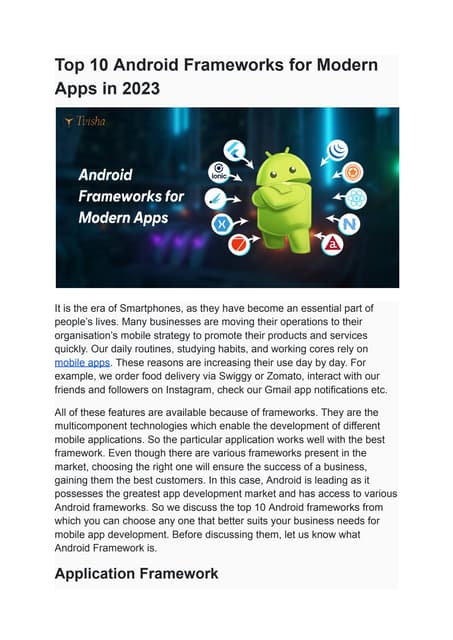



Top 10 Android Frameworks for Modern.pdfsuryamahathi1
Ěý
Put an end to your search for the right Android app development company here! Right from wire-framing to design and development, we've got you covered!Best Android Frameworks For App Development In 2023.pdf



Best Android Frameworks For App Development In 2023.pdfchristiemarie4
Ěý
Frameworks are used to develop robust and feature-rich mobile applications. Read the blog and know 2023's best Android frameworks and their key features.Cross-platform App Development Company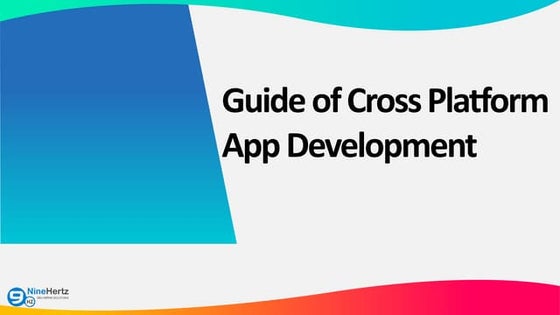



Cross-platform App Development CompanyThe NineHertz
Ěý
This document provides a guide to cross-platform mobile app development. It discusses how cross-platform apps can save money by requiring less development costs and reaching a wider audience. Native apps require separate development for each platform, while cross-platform uses one codebase. Popular cross-platform tools include React Native, Xamarin, Ionic, and Flutter. Factors like costs, time savings, and audience reach make cross-platform development beneficial for many businesses.Mobile App Development



Mobile App DevelopmentChetnaPatil34
Ěý
Trawex Technologies is a new generation Technology Services company initiated by a team of experienced IT professionals in Bangalore, India. Trawex is a mobile app development company, provides Mobile Apps, Mobile App Development Services, Travel Mobile Apps, to the travel industry globally. For more details, Please visit our website: https://www.trawex.com/mobile-app-development.php
Popular App Development Frameworks used by App Developers.



Popular App Development Frameworks used by App Developers.Techugo
Ěý
Mobile apps have been proven to be the best way for companies to increase their customer base. There have been many innovative app ideas. App development businesses were vital to ensuring that everything worked.
You can be proficient in simple computer languages to create an app. There are many platforms that allow you to develop apps for iOS and Android. You only need to grasp web-based programming languages such as HTML, CSS, or JavaScript.
Swiftic has been voted by one of the top mobile app development company for best tools on the iOS platform.
ADVANTAGES OF ANDROID APP DEVELOPMENT



ADVANTAGES OF ANDROID APP DEVELOPMENTtechugo
Ěý
Android app development comes with advantages in abundance. Click this PPT and explore further about Android Development advantages with Techugo- a top mobile app development company.Android presentation slide



Android presentation slideAPSMIND TECHNOLOGY PVT LTD.
Ěý
In this presentation i explain what is android, why we use android, advantage disadvantage, and how we create Android application.how android worked, Android framework description. Android Application Development procedure.Android Workshop Presentation



Android Workshop PresentationNAILBITER
Ěý
This document discusses the Android mobile operating system. It provides an overview of the different mobile operating systems including Android, Symbian, iOS, Blackberry OS, Samsung Bada, Windows Mobile, and Windows Phone 7. It then discusses Android's market share and key statistics for different original equipment manufacturers (OEMs). It introduces the Open Handset Alliance (OHA) and the key Google services available on Android. It also covers the Android app marketplace, factors contributing to Android's growth, and winners among end users, developers and service providers. Finally, it provides an introduction to the Android platform architecture, including the Linux kernel, native libraries, Android runtime, application framework, and application building blocks like activities, intents, services,Best android frameworks for app development in 2023.pdf



Best android frameworks for app development in 2023.pdfLaura Miller
Ěý
Frameworks are used to develop robust and feature-rich mobile applications. Read the blog and know 2023’s best Android frameworks and their key features.Most recommended android app development frameworks for app development



Most recommended android app development frameworks for app developmentAppsquadz Technologies
Ěý
Go through the blog Most recommended Android app development frameworks for app development to find out which one amongst all is as per your requirement.MOBILE APPLICATIONS DEVELOPMENT AND SERVICES.pptx



MOBILE APPLICATIONS DEVELOPMENT AND SERVICES.pptxmuthulakshmi cse
Ěý
The document discusses mobile application development and services. It covers the need for mobile applications, the cost of development, and importance of mobile strategies for businesses. It also discusses requirements gathering, third party frameworks like Appcelerator Titanium and PhoneGap, and publishing mobile applications. Marketing factors for developing mobile apps are also covered such as identifying the target audience and testing.Getting started with android programming



Getting started with android programmingPERKYTORIALS
Ěý
Android is an open source operating system used in phones, tablets, and other devices. This document provides an overview of getting started with Android programming, including introducing Android, setting up the development environment, creating a basic "Hello World" app, and debugging apps. Key aspects covered are the app publishing process, versioning apps, signing apps, and specifying API level requirements in the manifest file.The 8 Leading Frameworks for Cross-Platform App Development



The 8 Leading Frameworks for Cross-Platform App DevelopmentShiv Technolabs Pvt. Ltd.
Ěý
Check out our latest blog on the 8 most popular cross-platform app development frameworks. We’ve highlighted the best tools for mobile app development that simplify creating apps for various platforms. From React Native to Flutter, discover how these frameworks help you develop reliable apps that perform smoothly across different devices. For further insights, read our blog or book a free consultation with our IT experts today!Seminar on android app development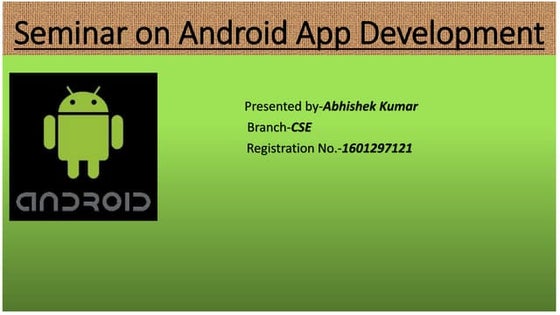



Seminar on android app developmentAbhishekKumar4779
Ěý
- Android is an open source operating system developed by Google that is used primarily for touchscreen mobile devices like smartphones and tablets. It is based on the Linux kernel and allows developers to write code using Java or Kotlin.
- The Android architecture consists of libraries and APIs on top of the Linux kernel, including a Dalvik virtual machine that executes applications. Apps are built using activities, fragments, intents and other components defined in the Android manifest file.
- Becoming an Android developer provides good career prospects with average salaries for entry-level positions around 3 lakhs per year in India. While Android has a huge user base, developing for its diverse ecosystem of devices can be challenging compared to platforms like iOS.Top 12 Reasons You Should Invest in Android App Development.pptx



Top 12 Reasons You Should Invest in Android App Development.pptxBytes Technolab Inc.
Ěý
Android is the world’s most popular mobile operating system, with over 2.5 billion active devices in use worldwide. This makes it an attractive platform for app developers looking to reach a large audience. Millions of business owners have opted for Android app development services or they simply hire Android app developers to build their next appWhich android app development tools deserve your attention this year 



Which android app development tools deserve your attention this year Moon Technolabs Pvt. Ltd.
Ěý
Android app development is still holding the reins of the market. If your preferred android app development company utilizes the tools elucidated here, your next project will be a guaranteed success.
001-Mobile Application.pptx



001-Mobile Application.pptxAhmedDarre
Ěý
The document provides an overview of the key phases in the mobile application development lifecycle:
1. Planning and research to define the app concept and target audience.
2. Assessing technical feasibility to determine the appropriate platform and backend requirements.
3. Creating wireframes and prototypes to design the user interface and flows.
4. Designing the visual aspects and user experience of the application.
5. Developing the app by coding features, integrating the backend, and testing functionality.
6. Thoroughly testing the app and fixing any bugs before deployment.
7. Deploying the app to appropriate app stores or servers.
8. Launching the app and promotingAndroid Internship report presentation



Android Internship report presentationvinayh.vaghamshi _
Ěý
Organizational study
Objective
Technology and associated platform
System architecture and design
Objective
Diagrams
Screen-shots
Future scope
References
Learn Android app development in easy steps
- 1. Submitted By: Mobilepundits http://www.mobilepundits.com/
- 3. Android Basics and User Interfaces
- 4. The Android frame work in divided and explained here so perfectly
- 5. Here is how the android SDK look
- 6. Android application life cycle
- 7. Android Application Activity Life Cycle
- 8. Service binding tree lifecycle
- 13. Linux Kernel
- 14. Core System Services • Security Management. • Process Management. • Memory Management. • Driver Model. • Network Stack
- 15. Core System
- 17. Android Applications Process Management
- 18. Android Application Process Image
- 19. Android Process Priority Diagram
- 22. Driver Model
- 23. Driver Behavior
- 25. Android Stack Source To Device
- 26. Libraries • Some other are. • System C Library. • Media Libraries. • SGL. • 3D Libraries. • FreeType. • SQLite.
- 27. Android Services Coding and Testing
- 28. iOS View controller LifeCycle from Android Activity LifeCycle
- 29. Updated Yamba Design with Receivers
- 30. How Android Determines What Resources to Use
- 31. Advantages of Android App Development • Low Investment & High ROI Android comparatively has a low barrier to entry. Android provides freely its Software Development Kit (SDK) to the developer community which minimizes the development and licensing costs. The development costs can be divided into three stages: Stage#1 – application development, Stage#2 – testing, and Stage#3 – hardware cost for testing and deploying the android mobile application.
- 32. • Open Source Get the open source advantage from licensing, royalty-free, and the best technology framework offered by the Android community. The architecture of the Android SDK is open-source which means you can actually interact with the community for the upcoming expansions of android mobile application development.  Easy to Integrate Are you looking for complex technical customization and integration of a web application or just a Smartphone application you already have? Yes. Then an android app can be the right solution for you. The entire platform is ready for customization. You can integrate and tweak the mobile app according to your business need. Android is the best mobile platform between the application and processes architecture. Most of the platforms allow background processes helping you to integrate the apps.
- 33. • Multiple Sales Channels Unlike other mobile platforms, Android applications can be deployed in different ways. You do not have to rely on a single market to distribute your applications. You can use third-party application marketplace (especially in Google Android Market), but you can also form your own distribution and sales channel: applications for vertical markets, to develop new application stores, and also place it on your website. You build it, you publish it. With your choice of promotional strategy, you can reach your end users through multiple channels. • Easy Adoption Android applications are scripted in Java language with the help of a rich set of libraries. Anyone can build Android applications with the knowledge of Java. According to a recent survey, a lot of Java programmers find it easy to adopt and script code for mobile applications in the Android OS. It is now very beneficial for Java developers to transition the code script into a mobile application, and can also implement android application development services in the app.
- 34. • If you want to develop any mobile application to grow your business fast , do not feel hesitate to contact. Our official e-mail id is marketing@mobilepundits.com





